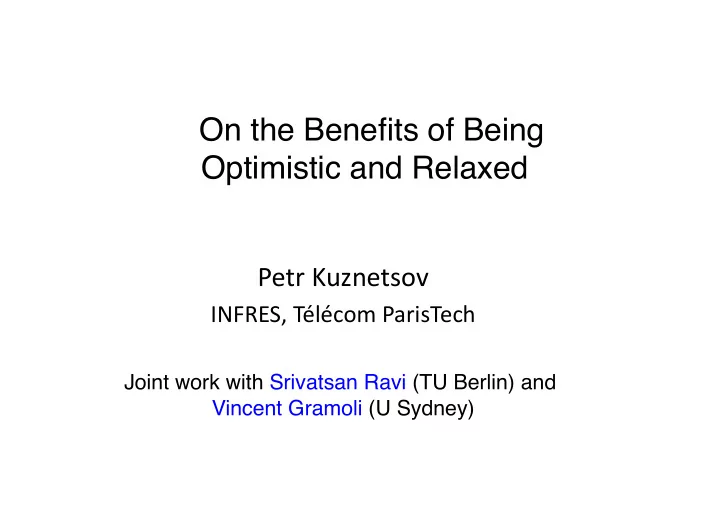

On the Benefits of Being Optimistic and Relaxed Petr Kuznetsov INFRES, Télécom ParisTech Joint work with Srivatsan Ravi (TU Berlin) and Vincent Gramoli (U Sydney)
What is computing? 2
3
4
5
6
7
8
Amdahl ʼ s Law p – fraction of the work that can be done in parallel (no synchronization), 1-p for synchronization n - the number of processors For n=9, p=9/10, S=5! S<9, regardless of n! Minimizing synchronization costs is crucial! 9
But… Concurrent programming is hard A new algorithm worth a PhD (or a paper at least) Sequential programming is “easy” e.g., for data structures (queues, trees, skip lists, hash tables,…) What about a “wrapper” that allows for running sequential operations concurrently? Let the wrapper care about conflicts How? Locks, transactional memory… 10
Our contribution What it means to share a sequential program Locally serializable (LS) linearizability What it means for sharing to be efficient Relative concurrency of different synchronization techniques (e.g., locks vs. TMs) What are the benefits of being relaxed and optimistic Type-specific (relaxed) consistency and transactional (optimistic) concurrency control supersede both 11
Correctly sharing sequential code? Given a sequential implementation P of a data structure type T, provide a concurrent one that: Locally appears sequential – the user simply runs the sequential code of P Local serializability Globally makes sense – the high-level operations give consistent global order wrt T Linearizability [HW90] 12
Example : Integer Set Type: Integer Set: boolean insert(x) boolean remove(x) boolean contains(x) Implemented sequentially as a sorted linked list: 2 5 … 7 9 h t 13
Linearizable histories insert(1) true insert(3) true p 1 contains(1) true p 2 remove(1) true p 3 The history is equivalent to a legal sequential history on a set (real-time order preserved) 14
Linked‐list for Integer Set: sequenQal implementaQon 15
As is? Insert(3) The update is lost! 3 H 2 T 5 Insert(5) Not LS-linearizable: locally serializable, but not linearizable… 16
insert(2) ok insert(3) ok ? p 1 Contains(3) false p 2 insert(5) ok p 3 • protect data items (critical sections), • provide roll-backs (transactions) 17
Locking schemes for a linked‐list Coarse‐grained locking … 2‐phase locking … Hand‐over‐hand locking: … relaxed for specific data structures 18
OpQmisQc wrapper for a linked‐list startTxn startTxn tryCommit tryCommit startTxn Plenty of STMs exist: • Opaque • Strictly serializable • Elastic • … tryCommit 19
What about efficiency? “Amount of concurrency”: the sets of accepted schedules (orderings of sequential steps) Each (correct) implementation accepts a subset of schedules The more schedules are accepted the better Which technique provides most concurrency? 20
Relaxation vs. Optimism PL : deadlock-free (fine-grained) lock-based M : strongly consistent (serializable) TMs R : relaxed (data-type-aware) TMs PL M R 21
22
Accepted by locks H T 1 3 4 p 1 p 2 p 3 Accepted by hand‐over‐hand p 1 and p 3 are consistent with different serializaQons 23
But not serializable! H T 1 3 4 T 1 T 2 T 3 T 1 ‐>T 2 (T 1 read X 1 before T 2 updated it) T 2 ‐>T 3 (T 3 sees the effect of T 2 ) T 3 ‐> T 1 (T 1 sees the effect T 3 ) 24
No writes: accepted by M • Both ops are about to write: rejected by M (at least one txn aborts) • But must be accepted by PL too! 25
R accepts every observable correct schedule of (LL,set) R accepts the linearizable but not serializable schedules of non-conflicting updates (1) R accepts the potentially conflicting-update schedule (2) (1) (2) 26
Results and implications What is a correct concurrent wrapper? LS-linearizability How to measure relative efficiency of concurrent wrappers? Accepted schedule sets Benefits of relaxation and optimism formally captured A language to reason about the “best” synchronization technique, the “most suitable” data structure 27
Open questions Extend the results to more general classes of types, data structures Workload analysis: which schedules are relevant? What concurrency tells us? The cost of concurrency? Details: http://arxiv.org/abs/1203.4751 28
Distributed ≠ Parallel The main challenge is efficient and robust synchronization ʻʻ you know you have a distributed system when the crash of a computer you ʼ ve never heard of stops you from getting any work done” (Lamport) 29
Merci beaucoup! 30
Recommend
More recommend